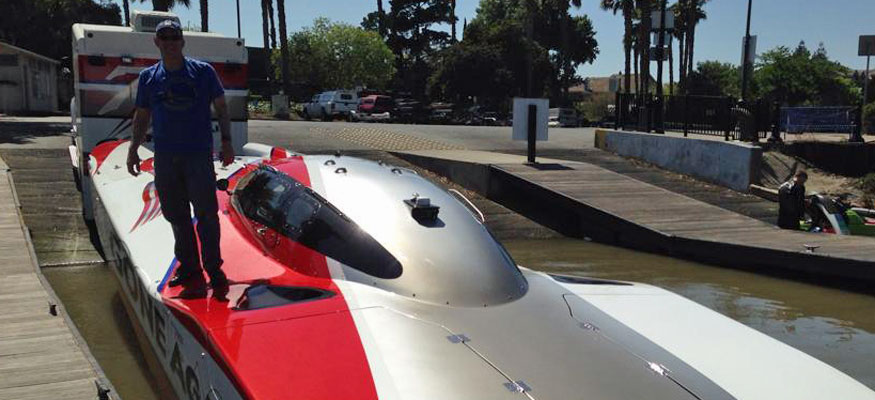Tres Martin’s Safety Corner: Grading The Course
Since speedonthewater.com launched this department almost a year ago, Performance Boat School founder Tres Martin has tackled subjects from the obvious such as how drinking and boating never mix to the subtle such as the hidden danger areas on your boat. When I caught up with Martin yesterday and we began brainstorming his next safety column, he was still pretty pumped up from the driving course he’d taught earlier this summer to Rick Bowling on Lake Tahoe in California. (Portions of the pristine lake also are in Nevada, but Bowling’s home is in a tiny California shoreline community called Carnelian Bay.)
Shown here on the deck of Gone Again, Bowling learned things in a few hours with Martin that he had not learned in hundreds of hours on his own.
Martin and Bowling tackled the on-water portion of the course in Bowling’s canopied 37-foot Talon catamaran called Gone Again, which was built in 1994 as an offshore raceboat and campaigned from 1996 to 2000 before Bowling converted it to a pleasure boat. Finished at last, or perhaps more accurately ” finished for now” as he never seems to stop tinkering with his cherished 37-footer, the cat is powered by a pair of Mercury Racing 1350 engines.
Since he first bought the boat, Bowling has logged hundreds of hours in it. But the most enlightening of those were the two or three he recently spent with Martin on Lake Tahoe.
“I learned a lot about my own boat,” Bowling says. “I thought I made messed it up (in the conversion from raceboat to pleasure boat). I thought my boat was squirrelly. But after working with Tres on turning and trim, I learned that isn’t the case. We started turning at 60 mph and moved up a little bit at a time until were we turning it at 100 mph. Tres was like a driver’s ed teacher—he kept showing me tricks and techniques, mostly in turning and trim with his hands and mine on the wheel, as we went along. We spent most of our time on the water just turning.
“My boat used to have this high-speed porpoise that we were able to get rid of by trimming it in a little more,” he continues. “We also stopped it from bow steering by using proper trim. Tres was really persistent in teaching me how to turn my own boat. I really liked it—and I learned a lot.”
Bowling says he found the prior day’s classroom instruction every bit as useful as the on-water portion of the program. For him, the course rated straight As across the board.
“Tres spent the first part of class talking about V-bottom design and the second part of class talking about catamaran design,” says Bowling. “He talked a lot about stepped hull technology, and how important it is to equalize the pressure on all steps as too much pressure on one step can cause problems when you slow down. We talked about what to do and what not do, especially going into a turn.
“It was all really helpful,” he adds. “I can see why guys take the course over again. Tres gives you so much information. I don’t think you can absorb it all.”


